2) Compare traditional photography to digital imaging. What are the main structual differences? How have value creation and value capture changed from traditional to digital photography? The main difference between traditional photography and digital imaging is that digital imaging doesn’t need physical films to take pictures and papers to see the pictures taken. This changed the customer experience of the whole process of enjoying pictures as below.
Traditional Photography Digital Photography. Eliminating of three processes, which were used to be necessary, buying films, visiting retailers, and waiting moved customers focus more to on cameras than films. Also as average digital camera price goes down, the sales increased promptly (Exhibit 11 and Exhibit 7, 8). For Kodak, before the digital cameras, the equipment (traditional camera) was just a tool to let people use their film and papers, especially for common family customers. However, as the value chain has changed, the company had to face competitions with not only traditional film makers, but also with camera manufacturers like Canon and Sony.
Even needed to compete or cooperate with high tech companies. Also, confronting the potential cannibalization within the company restrained Kodak from transformation to digital image business and made the situation worse for the company. In results, this digital imaging innovation has threatened the long-lasted hegemony of Kodak. Kodak 3) What is Kodak’s current position in digital imaging? Would Kodak’s position be different had the company adopted a different digital imaging strategy in the eighties and the nineties? Evaluate Kodak’s strategy starting in the mid-eighties.
Kodak still has biggest market share in the film market and the comparatively strong position in digital camera market, but it had some difficult time in the Photofinishing Market and has been loosing money in digital camera sales. Digital Camera: Kodak has about 13% market share of US digital camera market, which is the 2nd biggest. However the digital camera business is not making profit yet and expected to have very server competition among many other strong competitor, such as Sony, Cannon, HP, and Nikon(Exhibit 10).
Photofinishing Market: Due to previous contract, Kodak had difficulties to emerge to new strong channels such as Wal-Mart and Fuji has enjoyed the stronger position(60% M/S) in this market. Traditional Film Market: Kodak still has more than 30% of worldwide film market share(Exhibit 3) and maintained the number one position in Chinese market. But, the Fuji film came over the Kodak in terms of market share(Exhibit 3), and the entire film market is shrinking due to digital imaging. (Exhibit 12).
Kodak’s strategy in digital imaging from mid-eighties to mid-nineties was trying to shape the new market creating the “film-based digital imaging”. Even though they have invested in R&D and possessed patents for digital imaging technology, due to the huge profit from film business, management were retained to move on to new market and challenge. At the same time to avoid the cannibalization or to make something as profitable as color film, Kodak could not fully focus on digital formation and efficiently used its resources.
As it appears in the case, managements in Kodak certainly had no deep understandings in coming change through Internet(ex. People will pay to upload their pictures) and underestimated digital camera’s potential. In Kodak, digitalization was just “adding the flexibility offered by electronics. ” If Kodak focused more on the photography industry rather than diversification to different industries, such as pharmacy, it could have been used more dominant market position in the photography industry.
Also, the big mistake was too concerned about the cannibalization and satisfied with the profit of film business and too passive for innovation and adopting changes. Kodak should have used its strong R&D power and advanced technology for creating new ecology for digital imaging from capturing pictures(cameras) to Photofinishing. If so, it could have made the new standard in the digital market again and might be able to maintain its power. Kodak 4) What should Kodak do next? Kodak should reinforce the Photofinishing business, find a strategic partner or Digital Camera manufacturing, and expand to the home printing paper market. First, it should strengthen the Photofinishing business. Although it had difficulties in aggressively expanding its channels in Photofinishing market, but Kodak still has the biggest brand name in film and pretty big number of Photomaker kiosks and mini-lab stations. The share of pictures printed over pictures captured(Exhibit 14), however the retail portion of digital images printed market has rapid growth(CAGR 34%). This market is very familiar for Kodak and can expand without huge additional investment.
Second, Kodak should find a strategic partner for making more competitive digital camera. Appendix A explains about the competitors in digital camera business and most of them have long experience in camera manufacturing. Since Kodak didn’t focus on and succeed in the equipment business, it need to find a partner to address its weakness and prepare for the customers higher expectation in digital cameras as I mentioned in question 2. The capturing image criteria will be more important and Kodak will have difficulties to meet their needs even though they have no. market share currently using its brand name and already developed technology. Lastly, rapid growth of home image printing market will be another opportunity for Kodak since it has been enjoyed its privilege brand name in the paper category for long time. Strategic partnership with home printer makers such as Epson would secure soft landing in this market. Also Kodak branded special home printing papers for images will connect the memories of customers who have enjoyed the pictures on the Kodak papers.





